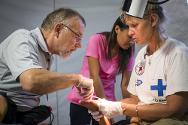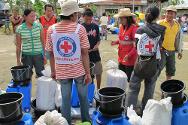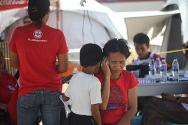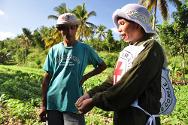How the ICRC helped people affected by conflict and natural disasters in the Philippines in 2013
25-02-2014 Facts and Figures
From the massive humanitarian needs arising from Typhoons Bopha (Pablo) and Haiyan (Yolanda) to the violence in Zamboanga, the ICRC responded to extremely complex situations in the Philippines in 2013.
The organization launched large-scale humanitarian responses with its operational partner, the Philippine Red Cross, to aid survivors of the successive emergencies, while continuing to carry out its regular activities helping detainees and communities affected by armed conflict.
Typhoon Haiyan response | Typhoon Bopha response | Zamboanga conflict response | Regular operations |
Typhoon Haiyan response
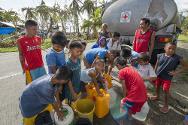
Emergency water distribution systems are set up by ICRC and PRC to provide clean drinking water to people displaced as a result of armed conflict and natural disaster.
© ICRC / B. Goris
Since early November 2013, when Typhoon Haiyan swept away villages, separated families, claimed thousands of lives and deprived people of their livelihoods, the ICRC and the Philippine Red Cross have been responding to needs on Samar Island.
While continuing to provide food rations, the two organizations have started early recovery programmes aimed at rebuilding livelihoods, providing shelter and repairing damaged health structures and water systems.
Providing emergency relief
- Delivered half-month food rations and household items to more than 163,000 people, and three-day food rations to nearly 60,000 people;
- Provided water, food, medical supplies and tarpaulins to affected detention facilities.
Enhancing access to clean water
- Distributed drinking water to over 85,000 people through water treatment plants;
- Repaired Guiuan’s water network, benefiting 32,000 people, and carried out training and technical support to Guiuan Water District staff
Supporting health care
- Established emergency health facilities in two municipalities, in partnership with the Norwegian and Finnish Red Cross Societies, and conducted over 6,600 outpatient consultations, 180 surgeries and 90 childbirths;
- Provided medical assistance to four hospitals, seven rural health units, and 50 barangay health stations, and repaired six rural health units, two district hospitals and 32 barangay health stations.
Restoring contact among relatives
- Launched FamilyLinks website, with subsequent enquiries from over 50,000 people;
- Helped 120 detainees contact their relatives through Red Cross Messages and satellite phone calls.
Typhoon Bopha response
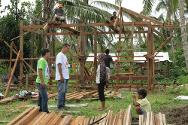
In those areas also affected by decades of armed conflict, ICRC helps people rebuild homes that have been completely destroyed by natural disasters.
© ICRC / S. Velasco
In December 2012, over 1,800 people were killed or went missing and over 900 were injured when Typhoon Bopha hit Eastern Mindanao, a conflict-affected region. Over the ensuing twelve months, the ICRC and the Philippine Red Cross launched a comprehensive response to aid survivors of the typhoon in the hardest-hit areas of Davao Oriental and Compostela Valley.
Providing emergency relief
- Provided food for over 288,000 people and household items and hygiene kits to 282,000 people;
- Delivered potable water for around 18,000 people in Davao Oriental;
- Distributed over 53,000 tarpaulins and 4,500 tool kits during the emergency phase.
Helping restore livelihoods
- Implemented cash-for-work projects for nearly 78,000 people;
- Donated seeds (vegetable, corn and chilli) for some 402,000 people.
- Provided cash grants to about 400 fishermen and farmers.
Supporting health care
- Set up a basic health-care unit in Davao Oriental, with support from the Japanese Red Cross, benefiting over 60,000 people;
- Provided medical supplies to two hospitals, five rural health units and one temporary health post.
Providing shelter
- Constructed over 3,000 permanent shelters for the most vulnerable families;
- Conducted training courses on best practice construction techniques for nearly 49,000 people;
- Repaired/helped repair 18 damaged health structures;
- Provided support to restore health services at a district hospital in Davao Oriental;
- Restored 14 damaged water supply network systems, benefiting more than 12,000 people.
Zamboanga conflict response
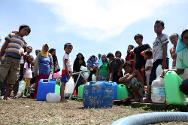
ICRC works to improve access to safe drinking water and sanitation for displaced people.
© ICRC / J. Maitem
In September 2013, clashes occurred in Zamboanga City in western Mindanao between members of the Moro National Liberation Front and government troops. The fighting, which lasted three weeks, resulted in a number of casualties and forced over 120,000 people to flee their homes. Over 10,000 structures were damaged or burned down.
At the onset of the crisis, the ICRC and the Philippine Red Cross carried out relief operations, ensuring access to clean water and emergency health care for displaced families. The assistance continues, with many families struggling to recover. The ICRC also visited nearly 300 people arrested in relation to the hostilities.
Providing emergency relief
- Provided hot meals to 146,000 displaced persons, and food, household items and hygiene kits to more than 16,500 displaced families;
- Installed 11 water bladders supplying clean water to 78,000 people;
- Installed 78 latrines in two evacuation centres;
- Provided clothes and hygiene items to those detained as a result of the hostilities.
Helping restore livelihoods
- Implemented cash-for-work programmes (cleaning of evacuation centres and building of communal tents) for about 6,000 displaced persons;
- Provided financial assistance to more than 25,000 people.
Supporting health care
- Assisted about 19,000 people through the basic health-care facility;
- Carried out a nutritional survey among the under-5 age group;
- Treated 60 wounded detainees and donated medical materials to authorities.
Regular operations
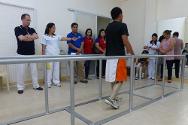
ICRC supports the Davao Jubilee Foundation benefiting amputees and patients with physical disabilities resulting from armed violence.
© ICRC / A. Madrazo
In the Philippines, where the ICRC has worked for over 60 years, the delegation focuses its humanitarian response on isolated areas of the country suffering from the often chronic consequences of long-running armed conflicts. According to the needs of affected communities, the ICRC delivers a range of integrated humanitarian activities, including access to water, livelihood support, and health-care services.
ICRC’s activities in places of detention are at the centre of its work in the country. It supports the authorities to ensure detainees are properly treated and to address the causes and consequences of overcrowding.
Promoting detainee welfare
- Assisted 28 jails and prisons in improving the delivery of health-care services for 38,000 detainees;
- Strengthened the TB control programme and provided quality treatment to around 600 TB patients in two places of detention;
- Supported the construction of a clinic and a laboratory at New Bilibid Prison and a medical-dental clinic in Quezon City Jail, benefiting over 25,000 inmates;
- Refurbished 14 jails to improve living conditions for more than 8,000 detainees.
Supporting health care
- Provided dressing materials and basic drugs to 23 hospitals in conflict-prone areas;
- Constructed a physiotherapy clinic at Davao Jubilee Foundation’s physical rehabilitation centre, which received more than 200 patients and provided 72 prosthetic limbs and orthotic materials.
Enhancing access to clean water
- Constructed a 33-kilometre water network for 15,000 people and a solar water supply system for 700 people in North Cotabato;
- Repaired a community-based water supply system in Surigao del Sur for 500 people;
- Constructed a gravity-fed water supply system in Negros Occidental for 1,800 people.
Helping restore livelihoods
- Donated seeds and fertilizers to more than 15,000 people in conflict-affected communities in Negros Occidental and North Cotabato;
- Built corn mills for almost 3,000 people in North Cotabato and Surigao del Sur to help reduce expenses;
- Helped set up a coconut-processing factory for 2,500 people in Sulu archipelago;
- Provided veterinary support to carabaos (water buffalos) previously distributed in North Cotabato;
- Conducted training courses on farming and animal husbandry techniques to over 2,200 people.
Providing support in times of emergency
- Delivered food, household items and hygiene kits to more than 20,000 displaced people affected by fighting between government forces and armed groups in June and October;
- Delivered food and hygiene kits to returnees/deportees from Sabah state and to people affected by the August flooding in Maguindanao and the earthquake in North Cotabato in June.
Promoting international humanitarian law (IHL)
- Organized training sessions and workshops on IHL to civil society groups, armed forces and police force personnel and government officials;
- Provided technical advice leading to the enactment of the Republic Act 10530 or Emblem Law;
- Organized the annual National Moot Court Competition on IHL for law students;
- Encouraged media to report on humanitarian issues by organizing a Red Cross Award for Humanitarian Reporting.
Supporting the national Red Cross Society
- Provided capacity-building support to over 300 volunteers from 22 Philippine Red Cross priority chapters considered as prone to natural disasters, violence or armed conflict.
